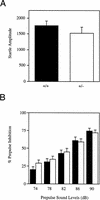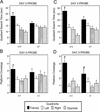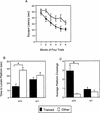Impaired learning and motor behavior in heterozygous Pafah1b1 (Lis1) mutant mice
- PMID: 10541472
- PMCID: PMC311310
- DOI: 10.1101/lm.6.5.521
Impaired learning and motor behavior in heterozygous Pafah1b1 (Lis1) mutant mice
Abstract
Heterozygous mutation or deletion of Pafab1b1 (LIS1) in humans is associated with syndromes with type 1 lissencephaly, a severe brain developmental disorder resulting from abnormal neuronal migration. We have created Lis1 heterozygous mutant mice by gene targeting. Heterozygous mutant mice are viable and fertile, but display global organizational brain defects as a result of impaired neuronal migration. To assess the functional impact of the mutation, Lis1 heterozygous mice and their wild-type littermates were evaluated on a wide variety of behavioral tests. Lis1 mutant mice displayed abnormal hindpaw clutching responses and were impaired on a rotarod test. Lis1 heterozygous mice were also impaired in the spatial learning version of the Morris water task. Impaired motor behavior and spatial learning and memory in Lis1 mutant mice indicates that impaired neuronal migration can have functional effects on complex behavioral responses. The behavioral findings also support the use of the Lis1 mutant mice as a model from human type 1 lissencephaly.
Figures








Similar articles
-
Genetic enhancement of the Lis1+/- phenotype by a heterozygous mutation in the adenomatous polyposis coli gene.Dev Neurosci. 2008;30(1-3):157-70. doi: 10.1159/000109860. Dev Neurosci. 2008. PMID: 18075263 Free PMC article.
-
Lissencephaly and LIS1: insights into the molecular mechanisms of neuronal migration and development.Clin Genet. 2007 Oct;72(4):296-304. doi: 10.1111/j.1399-0004.2007.00888.x. Clin Genet. 2007. PMID: 17850624 Review.
-
Aberrant dentate gyrus cytoarchitecture and fiber lamination in Lis1 mutant mice.Hippocampus. 2008;18(8):758-65. doi: 10.1002/hipo.20434. Hippocampus. 2008. PMID: 18446829
-
ALLN rescues an in vitro excitatory synaptic transmission deficit in Lis1 mutant mice.J Neurophysiol. 2013 Jan;109(2):429-36. doi: 10.1152/jn.00431.2012. Epub 2012 Oct 24. J Neurophysiol. 2013. PMID: 23100132 Free PMC article.
-
Murine modelling of classical lissencephaly.Neurogenetics. 1999 Apr;2(2):77-86. doi: 10.1007/s100480050056. Neurogenetics. 1999. PMID: 10369882 Review.
Cited by
-
Humanization for neurological disease modeling: A roadmap to increase the potential of Drosophila model systems.Animal Model Exp Med. 2023 Jun;6(3):230-236. doi: 10.1002/ame2.12322. Epub 2023 May 8. Animal Model Exp Med. 2023. PMID: 37323110 Free PMC article.
-
Using mouse transgenic and human stem cell technologies to model genetic mutations associated with schizophrenia and autism.Philos Trans R Soc Lond B Biol Sci. 2018 Mar 19;373(1742):20170037. doi: 10.1098/rstb.2017.0037. Philos Trans R Soc Lond B Biol Sci. 2018. PMID: 29352035 Free PMC article. Review.
-
Reversal of proliferation deficits caused by chromosome 16p13.11 microduplication through targeting NFκB signaling: an integrated study of patient-derived neuronal precursor cells, cerebral organoids and in vivo brain imaging.Mol Psychiatry. 2019 Feb;24(2):294-311. doi: 10.1038/s41380-018-0292-1. Epub 2018 Nov 6. Mol Psychiatry. 2019. PMID: 30401811 Free PMC article.
-
Inhibition of calpain increases LIS1 expression and partially rescues in vivo phenotypes in a mouse model of lissencephaly.Nat Med. 2009 Oct;15(10):1202-7. doi: 10.1038/nm.2023. Epub 2009 Sep 6. Nat Med. 2009. PMID: 19734909 Free PMC article.
-
Identification of hub ubiquitin ligase genes affecting Alzheimer's disease by analyzing transcriptome data from multiple brain regions.Sci Prog. 2021 Jan-Mar;104(1):368504211001146. doi: 10.1177/00368504211001146. Sci Prog. 2021. PMID: 33754896 Free PMC article.
References
-
- Abeliovich A, Paylor R, Chen C, Kim JJ, Wehner JM, Tonegawa S. PKCγ mutant mice exhibit mild learning deficits in spatial and contextual learning. Cell. 1993;75:1263–1271. - PubMed
-
- Aggleton JP, Hunt PR, Rawlins JNP. The effects of hippocampal lesions upon spatial and nonspatial tests of working memory. Behav Brain Res. 1986;19:133–146. - PubMed
-
- Albrecht U, Abu-Issa R, Ratz B, Hattori M, Aoki J, Arai H, Inoue K, Eichele KG. Platelet-activating factor acetylhydrolase expression and activity suggest a link between neuronal migration and platelet-activating factor. Dev Biol. 1996;180:579–593. - PubMed
-
- Alvarado MC, Ruby JW. Rats with damage to the hippocampal-formation are impaired on the transverse-patterning problem but not on elemental discriminations. Behav Neurosci. 1995;109:204–211. - PubMed
-
- Berger-Sweeney J, Hohmann CF. Behavioral consequences of abnormal cortical development: Insights into developmental disabilities. Behav Brain Res. 1997;86:121–142. - PubMed
Publication types
MeSH terms
Substances
Grants and funding
LinkOut - more resources
Full Text Sources
Medical
Molecular Biology Databases
Miscellaneous
